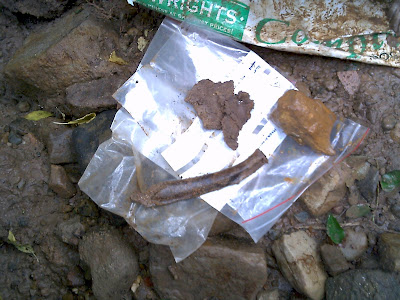Friday, 19 August 2011
New cervical vertabrae
The wrist band of the glove points to the hole in the packed gravels the cervical vertabrae was found.

Today after a lot of digging to remove collapsed lacustrine material using half a spade! it snapped! ive found a cervical vertebrae even further into the packed gravels, it doesn't mach bovine or horse.
Monday, 8 August 2011
Stainton gravel beds, and clay deposits.
These very good pics were taken by Andy cooper a geologist from tvriggs who has helped me a lot along with Alan, the two lads visited the site with me and although i had doubts about the group early doors i was totally won over by there professionalism and friendly approach, i am totally gob smacked about the level of Andy's commitment to discovering more about the geology of this area, the man deserves a medal!

 |
Isolated layer below |
 |
preserved organic layer underneath the Stainton gravel beds. |
I have recently collected and sieved a sample of the organic material pictured below and found a lot of what look to be hazelnuts and other unknown seeds, the hazelnuts are intact yet hollow.
Close up of a section of the Stainton gravel beds, with organic material between the two fine gravel layers, for some as yet unknown reason at least a third of these smaller gravels are highly magnetic, i am going to collect samples from deeper into the gravels for the tvrigs group to make a deeper petrographic analysis of the magnetic meterial. |
 |
One layer below my tea cup, and probably at least another two above the Stainton gravel beds pictured above. |
 |
| Close up of two separate layers |
Location:Cleveland England
Maltby, Middlesbrough, Stockton-on-Tees, UK
Wednesday, 20 July 2011
New bones excavated from the Stainton gravel beds.
The image above shows my latest find just above the trowel
The yellow glove marks the spot i started digging into the hard packed gravels, the new find is over 2 metres into the gravels.

The pic above shows the new find sitting above what i believe is the compressed remains of part of a preserved tree.
The gravels are visible above and below the preserved wood.
The pic above shows the fossil bone almost dug out with the blue- gray layer above.
These pics show the rib piece i have yet to identify it but it looks to have belonged to Ungulate
The yellow glove marks the spot i started digging into the hard packed gravels, the new find is over 2 metres into the gravels.

The pic above shows the new find sitting above what i believe is the compressed remains of part of a preserved tree.
The gravels are visible above and below the preserved wood.
The pic above shows the fossil bone almost dug out with the blue- gray layer above.
These pics show the rib piece i have yet to identify it but it looks to have belonged to Ungulate
Tuesday, 12 July 2011
Bone excavated from deposit above Stainton gravel beds.
Two of the bones join perfectly to the earlier proximal radius finds pictured below.
Note the fractures, i believe the bones would have broken as the river gravels became more compact.
These bones were found over 2 metres into the tightly packed river gravels, i am now in no doubt that most of the other bones ive found in this areas deep cutting becks, were originally buried in these gravels before the becks cut through releasing them. I also now believe the beck causes the black staining and the bones that have spent the most time in the becks natural recent sediments, ie fresh organic waste are more likely to have the black coating.
Note the fractures, i believe the bones would have broken as the river gravels became more compact.
All images and information was immediately sent to Tees Archaeology and the fact that this is a large cervid radius and ulna found in this condition in ancient river gravels seems of little interest.
These bones were found over 2 metres into the tightly packed river gravels, i am now in no doubt that most of the other bones ive found in this areas deep cutting becks, were originally buried in these gravels before the becks cut through releasing them. I also now believe the beck causes the black staining and the bones that have spent the most time in the becks natural recent sediments, ie fresh organic waste are more likely to have the black coating.
I have at the present time no way of knowing how long it took the beck to cut through the ancient river gravel layer so can't say how long this process takes. But bones found with the orange staining and concretions still attached have obviously been released from the river gravels more recently.
Subscribe to:
Comments (Atom)



































